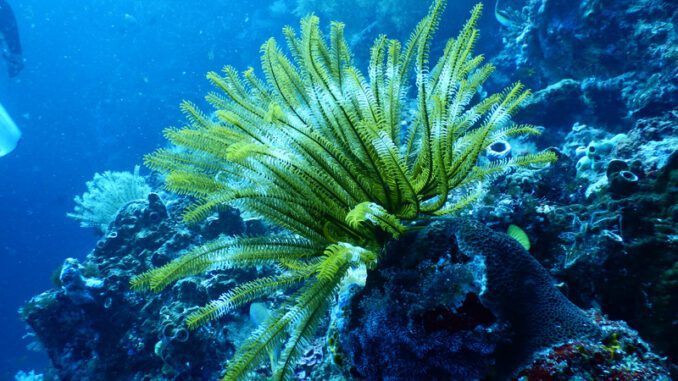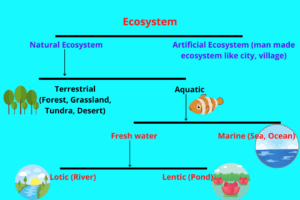
Introduction
The environment is created with everything around the organism. This environment is of two types, namely physical environment or abiotic environment, and biotic environment. The physical environment is composed of water, air, soil, etc. Whereas the biotic environment consists of plants and animals, which cannot survive without the physical environment. In order to discuss the habitat of organisms in this environment and their interrelationships in the environment, ecosystem discussion is a must. The system refers to a type of material that functions as a unit as a whole. All the organisms in a system and the inanimate environment around them function together as a single unit. This is called the ecological system or ecosystem definition in biology. In other words, organisms, environmental elements, populations, etc. all belong to the ecosystem (1).
Concept of ecosystem
From the end of the 17th century onwards, various texts began to publish research discussions on ecological relations. In 1877 scientist Karl Mobius, and in 1887 S. A. Forbes, wrote a number of scientific articles on the ecological relations of a particular region. Scientists start a new way of analyzing that relationship from an overall perspective. Later in 1935, A. G. Tansley first used the term ecosystem. At present, the concept of an ecosystem is a widely used subject in ecology (2).
Ecosystem definition in biology
The ecosystem word comes from two Greek words ‘eco’ means environment, and ‘system’ means interdepend.
An ecosystem is a natural unit consisting of organic, and inorganic matter, and various organisms where different form a way of life by interacting with each other and their surrounding organic and inorganic elements.
According to A. G. Tansley, ‘a functioning interacting system composed of one or more living organisms and their effective environment both physical and biological’ (2).
Components of ecosystem

The components of the ecosystem are mainly divided into two parts.
- Abiotic components.
- Biotic components.
Properties of ecosystem
1. The ecosystem has a specific area.
2. Ecosystem is observed in a temporal unit or measure.
3. Supply and production of energy and matter in the atmosphere is active at all times.
4. Only source of energy in the ecosystem is sunlight.
5. Size of an ecosystem can range from very small to large.
6. The ecosystem has a well-organized specific structure.
7. A permanent equilibrium state can be observed between the different components of the system (1) & (2).
Types of ecosystem

1. Terrestrial ecosystem
2. Aquatic ecosystem (1) & (2).
1. Terrestrial ecosystem
The natural ecosystem that develops mainly on land is called the terrestrial ecosystem. A terrestrial ecosystem is a ground-based organism and the interaction of biotic and abiotic elements in a specific area. The major ecosystems of land are as follows
A. Forest ecosystem
- A forest ecosystem is the most complex ecosystem. The producers in this ecosystem are the trees.
- The main functional system of this ecosystem is soil, trees, insects, animals, birds, and humans as its interactive units.
- Among all the ecosystems, forest ecosystems have the most species diversity. About one-third of the world is covered by forests.
- Soil, air, minerals, etc. are the abiotic elements of the forest ecosystem.
- Biotic ingredients include producers, consumers, and decomposers.
Forest ecosystems are divided into several categories based on their climate. These are
- Tropical forests
- Temperate forests
- Boreal or taiga forests.
These ecosystems contain more diverse flora and fauna than any other ecosystem in the world. In this warm, humid environment the trees grow taller and the leaves are denser. The species lives everywhere up to the canopy at the bottom of the forest.
In temperate regions, forest ecosystems can be thin, and conical, with some trees dropping each fruit on their leaves. The forest ecosystem is an important terrestrial environment that provides shelter to thousands of plant and animal species. Forest green plants collect inorganic material and make food with the help of solar energy.
The primary consumer or the herbivores take that food directly. Secondary consumers take primary consumers and tertiary consumers take secondary consumers as food. After the death of the producer and the consumer, the abiotic material is again dissociated by the decomposer and merged into the environment. As a result, there is a balance between the elements of the forest ecosystem (1) & (2).
B. Desert ecosystem
- Desert ecosystems are either vegetative or barren in nature.
- Every desert receives some amount of rain a year, but it is not distributed evenly everywhere.
- Deserts can be divided into two categories deserts and cold deserts. Examples of warm deserts are the Sahara of North Africa, the Kalahari of South Africa, the Thar of India, the desert of Mexico, the Atacama of South America, the Australian desert, California, and the Arizona desert.
- On the other hand, the deserts of Iran and Turkey, the Gabi desert of Mongolia, and a few deserts in Argentina are examples of temperate cold deserts.
The main feature of desert climate is low rainfall (less than 25 cm). Most of this rainfall occurs in just 50 days of the year. Other clear climate features of the desert include clear skies, hot daytime, and very cold nights. These areas have sparse plants, and rocky soils, and are covered with salt and sand. However depending on the availability of water, dates, barley, cotton, millet, etc. are cultivated in different places.
Desert plants are usually short-lived in nature. Their base is located at a depth of 1 m from the surface. As a result, they can easily collect rainwater. Their leaves are in many cases converted to scales or spines to reduce water consumption through evaporation.
The stems of desert plants are green and succulent, so they are capable of photosynthesis. The roots of the desert plants are long enough and extend to the groundwater. The initial productivity of the desert ecosystem is very low. Locusts, rats, camels, etc. are notable among the consumers in the desert ecosystem (1) & (2).
C. Grassland ecosystem
- Grasslands are mainly formed in temperate regions.
- Grassland ecosystems cover 20% of the earth’s surface.
- These ecosystems are affected by the organisms and plants that live there over time.
The grasslands are known by different names in different parts of the world.
- Prairies in North America
- Steppes in Europe and Asia
- Pampas in South America
- Veldt in South Africa
- Downs in Australia
There are three types of grasslands in the world namely
- Tropical grassland
- Temperate grassland
- Alpine grassland.
Tropical grasslands extend up to about 20° on either side of the equator. The average rainfall in these grasslands is 40-100 cm. The height of the grasses is about 1.5- 3.5 meters. In the middle of the continents, where the average annual rainfall is 85-100 cm.
The ecosystem is made up of various biotic and abiotic elements. This ecosystem is a region dominated by grasses and other medicinal plants. The grassland ecosystem is made up of abiotic elements like sulfur, carbon, hydrogen, phosphorus, etc.
The primary producers of this ecosystem are grasses. Cows, goats, rabbits, and rats are the primary consumers of the grassland ecosystem. They take grass as food. Snakes, lizards, foxes, frogs, etc. are the second consumers of grassland ecosystems.
Among the tertiary consumers of this ecosystem are the hawk, eagle, other hoofed mammals, etc. They usually survive by eating the primary and secondary consumers. The decomposers of the grassland ecosystem are actinomycetes, fungi, and soil bacteria, etc. They are decomposed and mixed with soil. This makes the soil fertile. And maintains the balance of the ecosystem (1) & (2).
D. Tundra ecosystem
- The word ‘tundra’ means a wetland plane. The arctic tundra region is predominantly plantless and barren in nature.
- However, grass, sage, lichen, etc. can be seen in some places. There are also rocky or submerged places somewhere.
- The soil is mixed with snow and frozen in depth.
The climatic features of this region are low temperature (daytime temperature less than 10°c in the warmest month), low precipitation, and permanent snow cover. The tundra region is divided into two parts namely the arctic tundra and the alpine tundra.
The arctic tundra region is called the real tundra. Different species of grasses and sedges grow in this ecosystem. Also found are bilberry, huckleberry, moss, lichen, etc. The overall productivity in this ecosystem is low. Among the herbivores are mosquitoes, flies, insects, migratory birds, etc.
Among the consumers are polar rabbits, polar goats, caribou, lemmings, etc are the main ones. Although the natural features of the alpine tundra region are similar to those of the polar tundra, drainage is relatively convenient in this region. The alpine tundra region is not evergreen. Plant growth is also longer here (1) & (2).
2. Aquatic ecosystem
This ecosystem is formed in water. In this type of ecosystem, the interrelationship between different types of aquatic animals, plants, and inorganic matter can be observed. Aquatic ecosystems cover about 70% of the earth’s surface. These ecosystems play an important role in the cycle rotation of various chemical elements. There are two types of this ecosystem. These are-
A. Freshwater ecosystem
This type of aquatic ecosystem is made up of fresh water. Freshwater ecosystems cover about 0.8% of the earth’s surface. The freshwater ecosystem includes ponds, rivers, lakes, streams, pools, wetlands, etc. There are two types of freshwater ecosystems. These are-
- Lentic ecosystem
Stable water ecosystems form lentic ecosystems. Ponds, pools, and lakes ecosystems are prime examples of lentic ecosystems. These ecosystems are habitats for algae, crabs, shrimps, frogs, etc. Also found are floating-living plants, reptiles, and other water snakes (1) & (2).
- Lotic ecosystem
Flowing water ecosystems form lotic ecosystems. The river is the main example of the lotic ecosystem. These types of ecosystems are habitat to species of insects such as beetles, stoneflies, mayflies, and different types of fishes like trout, eel, etc. Also seen in various mammals such as dolphins (1) & (2).
Marine ecosystem
The marine ecosystem is the largest ecosystem in the world. Different species of organisms live in this ecosystem. The total area of all oceans is about 15 times that of land. The various minerals that make up the crust rock are eroded and dissolved in ocean water. The presence of sodium chloride is the highest among these minerals.
Oceans, seas, intertidal zones, reefs, and seabed rock pools include marine ecosystems. Marine plants are the producers of this ecosystem. These ecosystems are habitats for shellfish, sharks, tube worms, crab small, marine mammals, seabirds, corals, etc. Marine ecosystems have greater salt content and greater biodiversity than freshwater ecosystems (1) & (2).
Importance of ecosystem
The ecosystem is the base of all the living and nonliving things. The continuity of the earth is only because of the ecosystem. It is one of the basic units of the natural environment and the biosphere. So the importance of the ecosystem in the environment is immense.
- Studying the ecosystem can give an idea about the different environments of the earth and its organisms.
- Maintaining an ideal ecosystem can in many cases protect against droughts and floods.
- The balance of carbon dioxide and oxygen in the air depends on the green plants in the ecosystem.
- The various elements of the environment rotate in cycles through the organic chemical cycle of the ecosystem.
- Air, water, and soil pollution can be reduced by knowledge of ecosystems.
- Ecosystems can be utilized to prevent environmental pollution as well as conserve natural resources.
- If the balance of the ecosystem is maintained, the extinction of plant and animal species will not take place (2)
